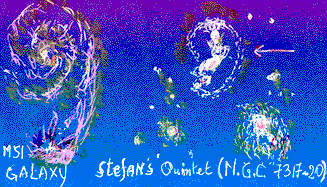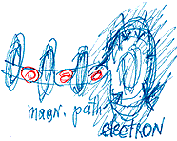Chapter 5 - Wave Theory and the Electron
Back to the Main Electron Page
To understand the electron’s structure and behaviour, let us look at the pictures of the Whirlpool Galaxy, M51 and Stefan’s Quintet (N.G.C. 7137-20) galaxies (pictures below). These pictures help us to imagine the electron’s structure as one possible way of connecting energetic formations. For a greater understanding, see the galaxy drawings below.


Cloud-like formations of energetic matter appear near the point at which the paths join the swirls. At the apex of the magnetic (Schwarzschild) swirl, we see a tightly held cloud of energetic matter flowing toward it from the energetic (Kerr) swirl. This cloud forms when the swirl cannot handle all the energy flowing to it. Energetic matter from the Schwarzschild swirl flows along a magnetic path and creates a more loosely held cloud of energetic matter near the confluence of the Kerr swirl.
Every energetic path is composed of magnetic and energetic rings, but the proportions and behaviour of the rings are different in each path. The energetic cloud is not static. It is a living formation of swirling and vibrating energetic matter. The cloud near the Kerr swirl rotates in a perpendicular direction, as does the magnetic loop. It is part of the magnetic paths and is very loosely connected to both the paths and to the swirl.
From beautiful pictures obtained of the sun, we see that energetic matter expelled from the star moves in the form of a swirl (picture below). This energetic path is probably mainly composed of magnetic loops, because the energetic loops that look like dark circles on the surface of the sun are composed of invisible energetic (dark) matter.

Before it is sucked into the Kerr swirl, the magnetic path creates a
swirling cloud. Perhaps, in the atom, this formation is the electron (a
moving cloud). The Kerr swirl, which behaves like a black hole, can swallow
only small amounts of energy. Excess energy is concentrated near the mouth
of the swirl and grows, achieving more mobility and space. In the atom,
the  electron
cloud appears to be more independent and jumps to a higher orbit. Perhaps,
rather than actually jumping to a higher orbit, the electron cloud enlarges
its space enough to come in contact with the higher orbit.
electron
cloud appears to be more independent and jumps to a higher orbit. Perhaps,
rather than actually jumping to a higher orbit, the electron cloud enlarges
its space enough to come in contact with the higher orbit.
The enlargement of the electron cloud’s space, caused by the addition of energy, enables it to form relationships with swirls of other atoms. Because it is magnetic, it connects with positron loops near Schwarzschild swirls and creates a small photon-like wave (picture to the right). The cloud, however, does not lose contact with the matter from which it originated.
Because the electron cloud belongs to the magnetic path (picture below and to the right), it moves in a perpendicular path from north to south or south to north, or around the energetic swirl (proton) - but only in the direction of the swirl’s rotation, west to east. This is the rotation of atomic energy formations.
 By
adding more energy, the electron cloud can separate itself from its wave
and become a high-energy independent magnetic loop (electron), flowing
between atoms in the energetic path. Once the atom from which the electron
originated creates another cloud of excess energy, the lost electron cannot
return to its original wave. If it is connected to magnetic paths, the
electron can jump orbits when energy is added, and return to its original
size when energy is lost. Every atom has its specific energy level, space
and time. When energy is added, their orbits cannot exceed the energy
level of the original wave. Excess energy is expelled in the form of photons
bearing the characteristics of the atom releasing them.
By
adding more energy, the electron cloud can separate itself from its wave
and become a high-energy independent magnetic loop (electron), flowing
between atoms in the energetic path. Once the atom from which the electron
originated creates another cloud of excess energy, the lost electron cannot
return to its original wave. If it is connected to magnetic paths, the
electron can jump orbits when energy is added, and return to its original
size when energy is lost. Every atom has its specific energy level, space
and time. When energy is added, their orbits cannot exceed the energy
level of the original wave. Excess energy is expelled in the form of photons
bearing the characteristics of the atom releasing them.
Every electron has its own space, spin, momentum and mass (interaction
between energetic formations), and is a  high-energy,
independent formation. As its behaviour is derived from the Schwarzschild
swirl, so its rotation is like the vertical, magnetic loop of a wave (see
the chapter on quarks). The electron’s polarity is negative; this
differs from the energetic swirl and path (picture right).
high-energy,
independent formation. As its behaviour is derived from the Schwarzschild
swirl, so its rotation is like the vertical, magnetic loop of a wave (see
the chapter on quarks). The electron’s polarity is negative; this
differs from the energetic swirl and path (picture right).
In front of the magnetic swirl is a positron: a concentrated swirl of energetic matter from the energetic swirl, having a horizontal plane of rotation. When an electron (a swirl with magnetic properties) collides with a positron, a high-energy wave (photon) is formed (picture below).

In molecules, however, the connection between the positron and the electron appears like a wave formation, and magnetic energy from both atoms circulates as one magnetic swirl in the molecule’s space.
Electricity is the movement of energetic matter in wires around the surface of electrons (magnetic loops). The electrons cannot handle the excess energy, and so the energy continues to move onward. The electron is not a static object rotating around a proton (energetic swirl), but a living formation, constantly changing position and energy levels. As stated by Feynman, orbit changes are very characteristic of electrons. Energy loss in atoms occurs mainly through electrons (vibration).
 The
nucleus of the atom is composed of photon-like structures strongly connected
by their energetic loops (picture near right). The connection between
atoms and molecules is the result of the electron (picture far right):
an energetic condensate cloud in front of the energetic swirl, waiting
to be swallowed by it. The swirl slowly melts the matter until a singularity
is formed, which ejects the energy. The energy becomes a magnetic loop
that, in turn, creates another electron cloud of condensate energetic
matter.
The
nucleus of the atom is composed of photon-like structures strongly connected
by their energetic loops (picture near right). The connection between
atoms and molecules is the result of the electron (picture far right):
an energetic condensate cloud in front of the energetic swirl, waiting
to be swallowed by it. The swirl slowly melts the matter until a singularity
is formed, which ejects the energy. The energy becomes a magnetic loop
that, in turn, creates another electron cloud of condensate energetic
matter.
Every addition of energy enlarges the cloud, but not the swirl, which
cannot exceed its original size. The electron can thus come into contact
with other swirls or jump orbits (temporarily enlarge its space).
Disconnecting atoms and molecules occurs by adding energy and enlarging
the magnetic path connecting the electron. In strong  magnetic
fields, one atom of a molecule travels to the north pole of a magnet and
a second travels to the south. It is very important to understand molecular
bonds. In the picture to your right, A2 molecules travel to opposite magnetic
poles, demonstrating that they have different directions of rotation.
magnetic
fields, one atom of a molecule travels to the north pole of a magnet and
a second travels to the south. It is very important to understand molecular
bonds. In the picture to your right, A2 molecules travel to opposite magnetic
poles, demonstrating that they have different directions of rotation.
Atoms in molecules rotate in opposite directions. The theoretical structure of molecules is a very complex energetic matter bond. The most important bonds between atoms and molecules are by electrons, the most mobile formation in the atom. By adding energy it can extend its space and easily come in contact with a positron and create a wave formation (positron + electron = electro-magnetic wave). The wave from two high-energy formations is high-energy. It can be separated by adding energy or by a lack of energy, as occurs in organic formations. A hydrogen electron in organic bonds, with its large radius, is very sensitive to downward energy shifts that decrease its size. In the sodium atom, the second level photon is large and the electron has a large radius that easily creates molecular bounds.
In the atom, bonding is carried out by energetic loops. We see clearly that their pulling forces maintain the structure, while the pushing forces of magnetic loops weaken it. In molecules, where bonding is by magnetic electron swirls, the structure is weaker and needs more energy to maintain it. Distances between atoms (waves) in a molecule are larger than between photons (waves) in the atom’s nucleus; they can easily be separated or joined.
Molecular bonds create energetic swirls between and around atoms. In astronomical observations of celestial clusters, we see similar formations that resemble beehives.
Energetic matters’ behaviour is the same in formations of all sizes. Energy circulation in all objects must be executed by wave formations. It is sometimes very difficult to find a wave formation in an object, but by careful observation we may do so.
Molecule Bonds
Single energy formations like atoms must join others to create a closed
swirl formation that is capable of stabilizing energy. In this formation,
in addition to the each atom’s individual swirl, there is a common
central swirl that maintains energy in a stronger fashion than the single
atoms did. These central swirls can be highly energetic, as in atoms,
or weakly magnetic, as in molecules. Every closed formation has one purpose:
to maintain energy, which is inflationary and tries to escape into space.
The following picture shows the molecule connections:

From this picture, we see that adding energy elongates the magnetic path and enlarge the space between the electron and the energetic swirl. The electron cloud comes in contact with the positron cloud in front of the magnetic swirl of a neighbouring atom, creating a large, high-energy positron-electron wave-like formation. By adding energy, the electron can be easily separated from the positron of the second atom; the electron will not, however, escape from its own atom. An enormous amount of energy is required to enlarge the electron’s space and enable it to escape the atom’s wave.
Every atom must gather its characteristic requirement of energy to jump to a new orbit. This orbit is a new, fluctuating energetic path, connected by double paths to the magnetic and energetic swirls.
- end -
Back to Top
Dr. Chaim Tejman, Copyright© 2001. All rights reserved.